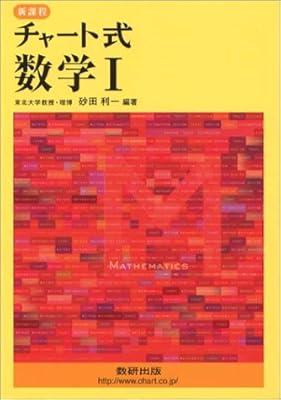
Toshikazu Sunada (Written by)
Zuken Publishing Co., Ltd. (Publishing House)
2003April 1, 2016 (Release date)
Hardcover (Format)
I'll figure it out today.。
It's from question 48.。
As in the hint\(\sin { \theta } =\tan { \theta } \cos { \theta } \)When you notice、\(f\left( \theta \right) \)can be transformed into the shape of a product、Take advantage of this。
(1)You just have to solve it normally.。
(2)The \(f\left( \theta \right)<0 \)So、The two terms of the product\(0\)is the larger and smaller。
The rest\(0°<\theta <180°\)(However,\(\theta \neq 90°\)When、\(\tan { \theta } <1\)To be\(0°<\theta <45°\)、\(90°<\theta <180°\)It's a good idea to pay attention to。
I accidentally made a mistake.。
You have to be careful.。
Next is Question 49.。
This is
$$\sin ^{ 2 }{ x } +\cos ^{ 2 }{ x } =1$$
$$\sin ^{ 2 }{ y } +\cos ^{ 2 }{ y } =1$$
If you use the formula that、Because four variables and four expressions, the equation can be solved if it is connected.。
I solved it using the formula of the synthesis of the triangle function like the following.。
$$a\sin { \theta } +b\cos { \theta } =\sqrt { { a }^{ 2 }+{ b }^{ 2 } } \sin { \left( \theta +\alpha \right) } $$
$$(ただし、\cos { \alpha } =\frac { a }{ \sqrt { { a }^{ 2 }+{ b }^{ 2 } } } ,\quad \sin { \alpha } =\frac { b }{ \sqrt { { a }^{ 2 }+{ b }^{ 2 } } } )$$
You don't have to use this formula to solve it.。
This problem was very easy.。
Next is question 50.。
Given\(f\left( \theta \right) \)From the expression of\(\sin { \theta } \)Turn it off.、\(\cos { \theta } \)It is assumed that it is an expression only.。
The rest\(\cos { \theta }=t \)And so on and so on\(f\left( t \right) =a{ t }^{ 2 }+2t-a\)Toshi、\(t\)in the range of、2Just find the minimum value of the next function.。
Here\(a=0\)And in the case of\(a>0\)In the case of、\(a<0\)It is note that it is necessary to divide it into the case of。
I forgot this、I made a mistake again.。
That's why it turned out to be a funny answer.。
Question 51 at the end。
It's a matter of triangles and circumscribed circles.。
(1)can be solved normally by sine theorem。
(2)according to the answer example、\(r+R\)But\(AP\)Because it is represented by、\(AP\)It seems to be good to think about the range which can be taking。
It seems to be OK if I lower the perpendicular AH from A to the side BC.。
As for me\(\angle CAP=\alpha \)And, please.、\(0°<\alpha <75°\)because\(r+R\)determined the range of。
Simply、Additive theorem of triangular function、Because I calculated it using a synthetic formula、The calculation has become complicated.。
It's going to take time.、The risk of miscalculation increases, too.。
It's easy to calculate like a correct answer.。
Today is the end of here!。
I hope to finish Chapter 3 "Shapes and Weighing" next time.。
Related Posts
- Chart Type Mathematics 1 Part11 [Secondary Function Edition] Toshikazu Sunada (Written by)Zuken Publishing Co., Ltd. (Publishing House)2003April 1, 2016 (Release date)Hardcover (Format) 今回も解いていく。今日は問33からだ。絶対値がたくさんついている。僕はヒントに従って、\(N=2\)のときと\(N=3\)のときを計算してみて、あとは\(N\)が偶数と奇数の場合に分けて、なんとなく答えを出した。However,、正答を見てみると、以下のように回答していた。 $${ a }_{ k }\le x\le { a }_{ k+1 }\quad \left( k=1,2,\cdot \cdot \cdot \cdot \cdot \cdot ,N-1 \right) のとき$$ $$f\left( x \right) =\left( -N+2k \right) x-{ a }_{ 1 }-{ a }_{ 2 }-\cdot \cdot \cdot \cdot \cdot \cdot -{ a }_{ k }+{ a }_{ k+1 }+\cdot \cdot \cdot \cdot \cdot \cdot +{ a }_{ N }$$ あとは\(N\)が偶数の場合と奇数の場合で、\(-N+2k\)が正か負か0かに着目してグラフの形を考えてみれば解けるみたい。こうやってしっかり解かないといけなかったみたいだ。数学2の単調増加、単調減少の考え方も入っているのかな。 次は問34。(1)はまず、2次方程式が異なる実数の2解を持つように判別式\(D>0\)とすればいい。そして共通解を\(x=\alpha \)And so on and so on、2本の2次方程式に代入して計算すると、\({ \alpha }^{ 2 }\)の項がうまい具合に消えて、\(\alpha=1\)と分かる。これで\(a\)の範囲が求められる。(2)は\(f\left( x \right) ={ x }^{ 2 }+ax+4\)、\(g\left( x \right) ={ x }^{ 2 }+4x+\alpha \)And so on and so on、グラフを書いてみる。あとは\(f\left( x \right)\)と\(g\left( x \right)\)が\(x=1\)で交わることに注意してグラフから実数解の大小を考えればいいだろう。 そして問35。\(x\)と\(p\)で表される放物線と三角形が交わるような実数\(p\)の範囲を求めよという問題だ。僕はまずヒントにしたがって放物線が三角形の各頂点を通るときの\(p\)を求めた。あとは\(f\left( x \right) ={ \left( x-p…
- Chart math 1 part13 [shape and weighing] Toshikazu Sunada (Written by) Zuken Publishing Co., Ltd. (Publishing House) 2003April 1, 2016 (Release date) Hardcover (Format) 第3章「図形と計量」に進んだ。 総合演習をAから解いていこう。 三角比とかが出題されるみたいだな。 まずは問38。 僕はいろいろな公式を使って式を変形して解いた。 以下のようなものだ。 $$\sin ^{ 2 }{ \alpha =\frac { 1-\cos { 2\alpha } }{ 2 } } $$ $$\cos ^{ 2 }{ \alpha =\frac { 1+\cos { 2\alpha } }{ 2 } } $$ $$\sin { \left( 90°-\alpha \right) } =\cos { \alpha } $$ $$\cos { \left( 90°-\alpha \right) } =\sin { \alpha } $$ But、今\(\alpha =22.5°\)なので\(3\alpha =90°-\alpha \)、\(5\alpha =180°-3\alpha \)、\(7\alpha =180°-\alpha \)であることに注目すれば、式が\(\sin { \alpha } \)、\(\cos { \alpha } \)のみで表されて、もっと簡単になったみたいだ。 次は問39。 以下の公式を用いて、変形していけば簡単に解ける。 $$\sin ^{ 2 }{ \theta + } \cos ^{ 2 }{ \theta =1…
- Chart Equation Mathematics 1 Part4 [Equations and Inetheles] Toshikazu Sunada (Written by)Zuken Publishing Co., Ltd. (Publishing House)2003April 1, 2016 (Release date)Hardcover (Format) I'll figure it out today.。問12からだ。ヒントによると\(x\)に関する2次方程式の解がすべて有理数となる条件は、判別式\(D\)が平方数であることだという。え~っと、2次方程式\(a{ x }^{ 2 }+bx+c=0\)の解は、解の公式を用いて次式で表される。 $$x=\frac { -b\pm \sqrt { { B }^{ 2 }-4ac } }{ 2a }=\frac { -b\pm \sqrt { D } }{ 2a }\tag{1} $$ 有理数とは分数\(\frac { m }{ n } \)(\(m\)、\(n\)は整数、\(n\neq 0\))の形で表される数であるという。たしかに、\(a\)、\(b\)、\(c\)が整数のとき、\(\sqrt { D } \)が有理数なら\(x\)は有理数になる。\(\sqrt { D } \)が無理数なら有理数\(+\)無理数で\(x\)は無理数だな。As for me $${ m }^{ 2 }-28={ l }^{ 2 }$$ (\(l\)は\(0\)以上の整数)とおいて、\(m\)の範囲を\(2\sqrt { 7 } \le m\le 14\)と見つけてから、総当たりで探していった。However,、回答を見るともっと簡単なやり方があったようだ。 $${ m }^{ 2 }-{ l }^{ 2 }=28$$ $$\left( m+l \right) \left( m-l \right) =28$$ として、\(m\)が自然数、\(l\)が\(0\)以上の整数であることと、\(m+l\)、\(m-l\)の差が偶数であり両者は奇数または偶数であることから、\(m+l=14\)、\(m-l=2\)と決まってしまうらしい。こっちのほうが分かりやすいな。 次は問13。A問題が終了ということで、ちょっと難しくなるのだろうか。まぁやっていこう。(1)は普通に計算すればいいな。(2)も $$ac+bd=1\tag{1}$$ $$ad-bc=0\tag{2}$$ これら2式に\(a\)、\(b\)、\(c\)、\(d\)をかけて足したり引いたりして変形すると答えが求まる。 そして問14。(1)は簡単。(2)は分からなくて迷った。ヒントには平方の差を作ると書いてあるが、う~ん?しばらく悩んだがやはり分からなかったので答えを見た。なんだ、そういうことだったのか。係数が実数の範囲で因数分解するとは下のようなことをすればよかったらしい。 $$\begin{eqnarray*}{ x }^{ 6 }+1&=&\left( { x }^{ 2 }+1…



